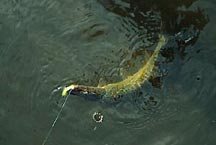 Chesapeake Outdoors by C.D. Dollar
Chesapeake Outdoors by C.D. Dollar
Spring Bites with Sharp Teeth
Warm air once again wafts into my lungs, lingering like a dream so delicious. That’s spring’s scout, whispering promises to defrost winter’s chill and replace slushy creeks with free-moving, fish-holding water.
But we’ve been around the Chesapeake long enough not to trust this reprise; a late-season brew is very much a part of Old Man Winter’s bag of tricks.
Still, signs of the pending equinox are omnipresent. Bank fishermen jockey for position on creeks and bridge overpasses, dangling enticements for yellow perch making their annual spawning run to the finger tributaries of the rivers Chester, Patuxent and Choptank. Crows and gulls have been caught posing on osprey nests, their silhouettes just believable enough to make the observer do a double take. Or was that wishful thinking?
One of the precursors to full-out spring is chasing chain pickerel, a worthy adversary by any angling standard. This hard-fighting gamefish can be found in numerous brackish creeks, farm ponds on the Eastern Shore and lakes throughout Maryland.
 In past years, I’ve found these voracious feeders lurking in shallow cover in the Severn River, such as fallen timber and grass beds, waiting for the right time to ambush unsuspecting prey. Ray’s Pond, Brewer’s Creek and Chase Creek hold pike, including many over 20 inches.
In past years, I’ve found these voracious feeders lurking in shallow cover in the Severn River, such as fallen timber and grass beds, waiting for the right time to ambush unsuspecting prey. Ray’s Pond, Brewer’s Creek and Chase Creek hold pike, including many over 20 inches.
I haven’t fished the Magothy River in several years, but its smaller arteries, such as the Cypress and Cattail and even inside Sillery Bay, have held pretty good numbers of pickerel. South and Patuxent river anglers no doubt have their pet places.
Pike are generally not picky. They’ll eat various minnows and even fish up to half their own size. Spin and fly gear are exciting ways to land a toothy, angry pike. I like a six-weight outfit loaded with a sinking or sink-tip line topped with a balanced leader six to eight feet long. I also tie on a shock leader of, say, 20-pound test to reduce break-offs. Fluorocarbon helps when fish are leader-shy.
Fly patterns need not be complicated. Just think of the bait available and tie (or buy) your flies to match. Clousers — yellow over white, white over yellow, olive and yellow — tied on a long shank hook (#1 to 2/0) work well since they mimic several forage species. Years ago I learned from master fly fisher Joe Bruce to bulk up the body of the fly itself with more feathers or flash material for better jigging action. Lead eyes accomplish the same thing.
For spin casters, lightweight to medium rods loaded with four- and six-pound test are plenty stout enough. Again, a shock leader is good insurance against the pike’s bite. Various spinner baits (Mepps and such) and tube baits are effective, such as a two-inch black/chartreuse tube jig on a 1/16- to 1/8-ounce jig head attached to a gold #1 jig spinner. It’s one of Severn River pickerel aficionado John Page Williams’ favorites, making it good enough for me.
When the fish are less active, live bait sometimes provides the necessary incentive. Lip-hook a two-inch bull minnow onto a jig, and then retrieve it along the shoreline edges, near stumps and where grasses have died off.
Before the rockfish run, I’ll investigate potential pike lairs on the Shore, especially in the Chester and Corsica rivers, to see if I can’t coax a thunderous strike from one. Then I’ll really know spring is nearly here.
Fish Are Biting (Finally!)
More fishermen are taking advantage of the warm weather, which has raised water temperatures to mid-40 degrees, prime perch-run temperatures. Maryland Department of Natural Resources’ new fishing report guru, Keith Lockwood, told me last week that state biologists’ surveys reveal yellow perch are staging. So it shouldn’t be long before river herring and shad make their annual pilgrimages up the Chesapeake rivers, followed closely by rockfish.
to the top
